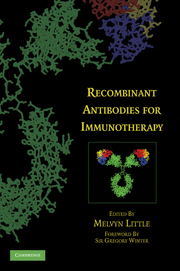Book contents
- Frontmatter
- Contents
- Contributors
- Foreword by Sir Gregory Winter
- Preface
- RECOMBINANT ANTIBODIES FOR IMMUNOTHERAPY
- PART I HUMANIZED ANTIBODIES
- 1 Humanization of Recombinant Antibodies
- 2 Immunogenicity Assessment of Antibody Therapeutics
- 3 In Vitro Screening for Antibody Immunogenicity
- PART II GENERATION AND SCREENING OF ANTIBODY LIBRARIES
- PART III TRANSGENIC HUMAN ANTIBODY REPERTOIRES
- PART IV ANTIBODY EFFECTOR FUNCTION
- PART V ARMING ANTIBODIES
- PART VI NOVEL ANTIBODY FORMATS
- PART VII ANTIGEN-BINDING REPERTOIRES OF NON-IMMUNOGLOBULIN PROTEINS
- PART VIII PROLONGATION OF SERUM HALF-LIFE
- PART IX INNOVATIVE IMMUNOTHERAPEUTIC APPROACHES
- PART X MARKET OVERVIEW AND OUTLOOK
- Index
- Plate section
- References
1 - Humanization of Recombinant Antibodies
from PART I - HUMANIZED ANTIBODIES
Published online by Cambridge University Press: 15 December 2009
- Frontmatter
- Contents
- Contributors
- Foreword by Sir Gregory Winter
- Preface
- RECOMBINANT ANTIBODIES FOR IMMUNOTHERAPY
- PART I HUMANIZED ANTIBODIES
- 1 Humanization of Recombinant Antibodies
- 2 Immunogenicity Assessment of Antibody Therapeutics
- 3 In Vitro Screening for Antibody Immunogenicity
- PART II GENERATION AND SCREENING OF ANTIBODY LIBRARIES
- PART III TRANSGENIC HUMAN ANTIBODY REPERTOIRES
- PART IV ANTIBODY EFFECTOR FUNCTION
- PART V ARMING ANTIBODIES
- PART VI NOVEL ANTIBODY FORMATS
- PART VII ANTIGEN-BINDING REPERTOIRES OF NON-IMMUNOGLOBULIN PROTEINS
- PART VIII PROLONGATION OF SERUM HALF-LIFE
- PART IX INNOVATIVE IMMUNOTHERAPEUTIC APPROACHES
- PART X MARKET OVERVIEW AND OUTLOOK
- Index
- Plate section
- References
Summary
Since 1890, when von Behring and Kitasato reported that animal antitoxin serum could protect against lethal doses of toxins in humans, antisera have been used to neutralize pathogens in acute disease as well as in prophylaxis. Antisera are also used in vitro as diagnostic tools to establish and monitor disease. However, antisera invariably induce an immune response resulting in joint pains, fevers, and sometimes life-threatening anaphylactic shock. Various proteins contribute to the immunogenicity, as the serum is a crude extract containing not only the antibodies against the disease-causing antigen (often at low concentration), but also other antibodies and proteins.
FULLY MOUSE TO FULLY HUMAN
In 1975, Köhler and Milstein (1975) at the Medical Research Council's (MRC) Laboratory of Molecular Biology in Cambridge (UK) reported their discovery of a way to produce custom-built antibodies in vitro with relative ease. They fused rodent antibody-producing cells with immortal tumor cells (myelomas) from the bone marrow of mice to produce hybridomas. A hybridoma combines the cancer cell's ability to reproduce almost indefinitely with the immune cell's ability to produce antibodies. Once screened to isolate the hybridomas yielding antibodies of the required antigen specificity and affinity – and given the right nutrients – a hybridoma will grow and divide, mass-producing antibodies of a single type (monoclonals). Nearly a century before, the German scientist Paul Ehrlich envisaged that such entities could be used as magic bullets to target and destroy human diseases, and hybridomas seemed like a production line of batch consistency for these magic bullets.
- Type
- Chapter
- Information
- Recombinant Antibodies for Immunotherapy , pp. 3 - 19Publisher: Cambridge University PressPrint publication year: 2009
References
- 5
- Cited by

